The R/V Thomas G. Thompson left Honolulu on November 5, 2011 heading toward the Western Pacific. This expedition journal was written by cruise participants and uploaded about once per weekday, depending on internet availability.
December 15, 2011: Preparing for Port
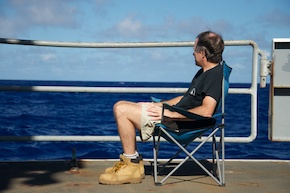
Science operations over (Credit: Will Koeppen)
As of December 13th, we finished our science operations and started our transit to Guam. This means that the crew of the R/V Thomas G. Thompson has a lot to get done in a short amount of time. With many years of experience under their belts, they manage to prepare for porting with ease almost every time. Every department on the ship has different goals to achieve, and I asked Chief Steward Sarah Wicker, Chief Engineer Terry Anderson, and Captain Patrick Donovan about what they do in order to prepare for port.
For Sarah, there is a three-day process during transit to port that is needed in order to prepare the food stores to take on new supplies. On the first day, she decides what food can be kept and what needs to be tossed. At this point in the cruise our perishable foods are running low, but there are still some "fresh" fruits and vegetables left. Sarah figures out what she needs for the rest of our transit, and then doubles that number (just to be sure we don't get hungry). Whatever is over that number, she needs to remove to make room. Lettuce, tomatoes, and dairy are a few examples of what has been thrown overboard. The packaging the food comes in is usually removed and incinerated; however, cardboard is biodegradable and breaks down quickly, so that goes over the side as well. On day two the cleaning begins, and the galley staff, Sarah, Terence, and Tony, start by moving anything on the shelves of the cold storage rooms to the deck (cold-room floor). The shelves are then cleaned, dried, and put back into place. On the final day, the food is then repacked on the shelves and the deck is cleaned. When new food is delivered to the ship, it is placed on the newly cleaned deck, and Sarah has a good idea of what needs to be eaten first (i.e., food on the shelves).
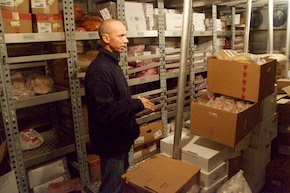
Terence in the stores (Credit: Will Koeppen)
Sarah also has the task of ordering food for the next cruise, which begins in late December. Even before we left the dock in Honolulu for this cruise, she prepared a list of what she thinks is needed for the next cruise. For most cruises Sarah orders around 8 pallets, each of which is a six-foot cube containing 30 to 40 cases of food. For our six-week cruise with 49 people on board, she ordered 13 pallets, which is over 400 cases (~5 tons). Around three weeks before arriving into Guam, Sarah and the captain work with the University of Washington's office in Seattle to finalize the food order. This can be a difficult task because it is hard to predict three weeks in advance what food is going to be tossed over board, and what is going to be needed for the next cruise. In Guam, Sarah does not have a food budget, which makes it easier to order the food she needs. She can also tailor the menu to what kinds of foods are available locally. When we dock in Guam, Sarah will meet with a chandler hired by the port agent to take care of the purchases of food and sometimes parts for the ship. The chandlers are usually accustomed to the country we are docking in, so they may suggest changes to Sarah's order based on what is in season (e.g., if oranges are not in season in Guam, there may be another fruit that is).
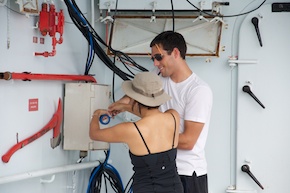
Science equipment also comes down
(Credit: Will Koeppen)
Many crew members have commented that the galley sets the tone of the cruise. If the food is good and there's a lot of variety, everyone on board is happier. For this cruise, that was definitely the case.
Before pulling into port Terry and his team of engineers identify any shortages on the R/V Thompson, such as fuel, oil, or mechanical parts. They need to know what supplies are available in the destination port and how they match up with what we are currently using on the ship. For example, the R/V Thompson normally uses Mobile oil in its engines, but they don't have that brand of oil in Guam. Terry did research and found that Shell oil is the closest substitute available on the island. The engineers also coordinate with the UW Seattle office to identify any equipment that is being put on or taken off the ship. In port, the crew and engineers are trained on how to operate and maintain the new equipment.
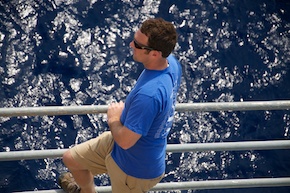
Preparing, mentally (Credit: Will Koeppen)
Captain Patrick also has a lot of responsibilities when pulling into port. These tasks are usually planned out over the course of the entire cruise, but the details are set in place a few days before docking. Patrick contacts the port agent to give him our estimated time of arrival, and they work together to get everything in order to make arrival run smoothly. This can include a lot of paperwork (e.g., we will be going through international customs in Guam). Patrick also needs to learn the port's security protocol; since we are pulling into a naval port, we need to be escorted by a tugboat. He also orders fuel for the next cruise (145,000 gallons), signs on and off any arriving or departing crew members, and arranges the crews' port schedules. The night before pulling into Guam, there will be a bridge team meeting to go over the route along with any potential hazards, turning points, or other considerations such as tides and weather.
Meanwhile, in the four days leading up to our arrival in Guam, the ABs swarm the decks cleaning, painting, sanding, and generally making the R/V Thompson shipshape.
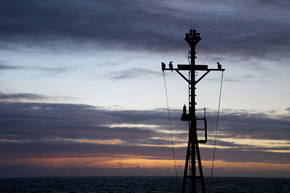
Getting on home (Credit: Will Koeppen)
When we pull into Apra Harbor, Patrick will switch everything, including steering, from automatic to manual. The captain and first mate are required to be on the bridge, and we will take on a local pilot as an advisor. They must follow a standardized protocol designed to minimize mistakes and accidents while entering or leaving ports. All of the other crew members are assigned specific tasks and places to assist in docking. And the science team, with their cameras at hand, will try to stay out of the way. ♦
